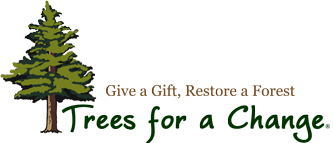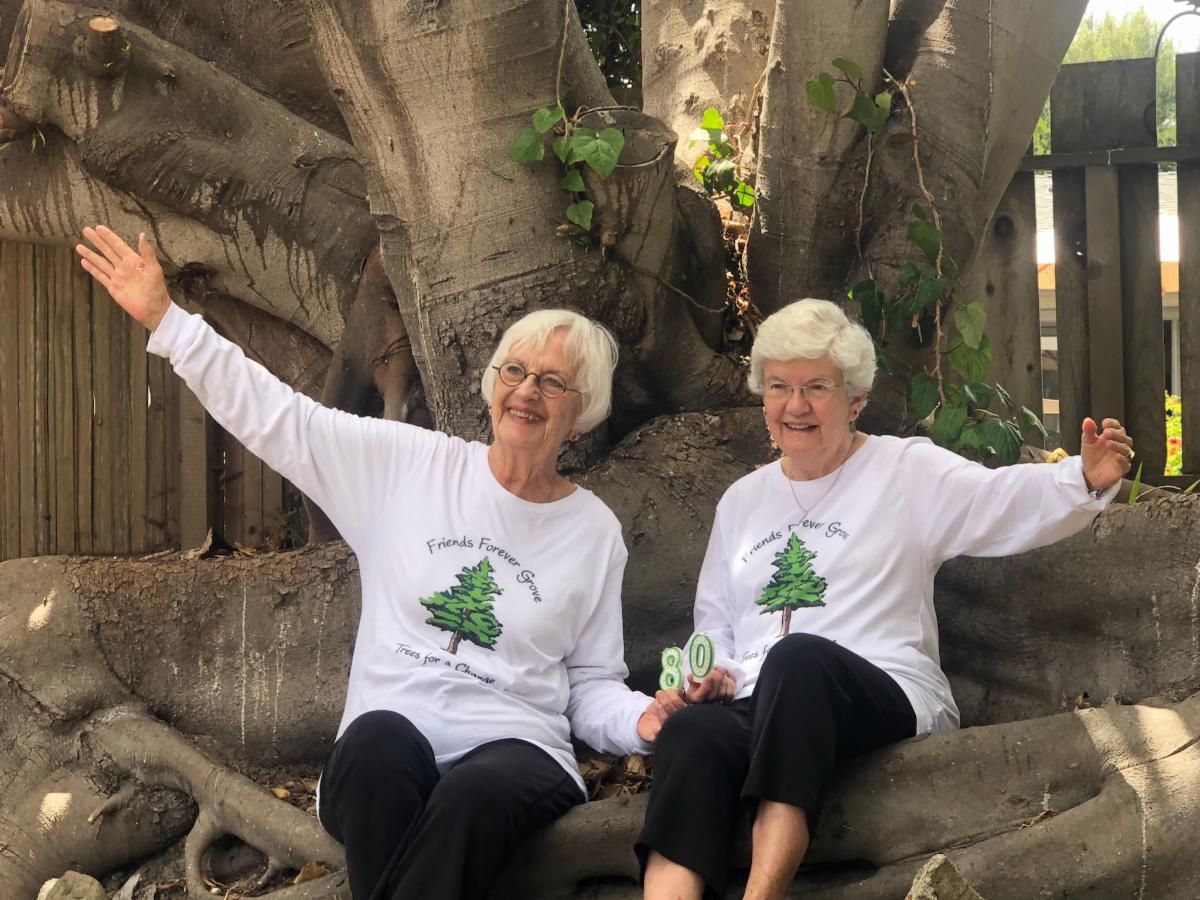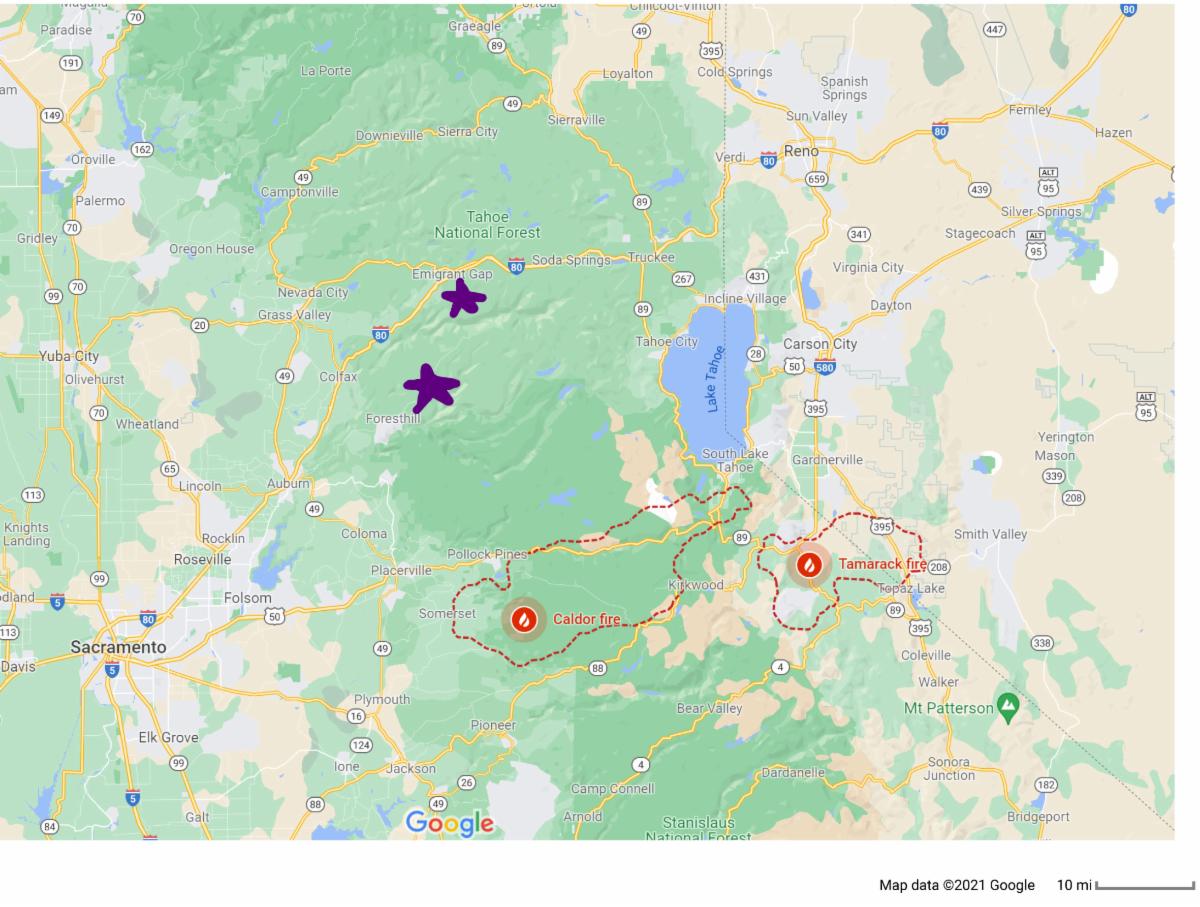A Stranger Saves the Day

The Angeles National Forest trees we planted in 2021 & 2022 struggled due to drought, so replacement trees were planted in 2023, but we had an impossible time taking photos because the road had washed out.
I returned in April 2024 knowing the road had been repaired, but the actual Forest Service road to get to the trees was in worse shape than I expected. Of course, this was the ONE TIME in 17 years I came to see the trees in a vehicle that was not 4 wheel drive, and of course this was the time it was really needed :(
That morning I had already traveled a bit to get there, so it was afternoon when I arrived. There was no time to hike up the dirt road before it got dark, but I was not giving up on seeing those trees!
I suggested to my friend/chauffer we stop in at The Rock Inn, the only restaurant/bar in the little town of Lake Hughes and see if someone could help us. I explained the situation to the bartender, Tanya, and asked for her help. Before I had even finished my sentence, she was on the phone with her adult daughter. 30 seconds later she hung up and said Toby, her son-in-law, was on his way with his Jeep.
Toby soon appeared, looking like a younger brother of ZZ Top, with an awesome mountain man beard. After assessing Toby seemed safe enough we hopped in his Jeep, "Scarlet," and set off to find the trees.
The drive was only about 3 miles, but the road was bumpy so we went pretty slow. We had a lovely time splashing through puddles and chatting up Toby. We learned he had spent his day off that day playing disc golf, he is really into the super cool haunted house he and his wife set up every year, and he is a massage therapist.
We found the baby trees, (YAY! FINALLY!) took photos, and I explained how much this meant to me all the way back to The Rock Inn.
Thanks to the trees, I spent a bit of my afternoon making an unexpected connection and having a fun adventure with a stranger who was kind and who loves nature just like I do.
THANK YOU, Toby. Sometimes I get a reminder of how beautiful people can be when I least expect it.
~Kim
PS- if want to visit the Angeles National Forest trees, Toby would be happy to take you up the dirt road in Scarlet. Contact us for his info.



A Family Visits Mom's Trees - 2024

Brandy has been missed dearly since she passed away from cancer in early 2023.
Her family received a 5 Tree Memorial Grove from a friend and it meant a lot to them.
The grove meant so much, in fact, that her husband of 14 years, Jeremy, traveled all the way from Nebraska with their three daughters, Madeline, Lillian and Norah to visit the baby trees last summer.
After they returned home, Jeremy shared photos of the trip with us and he said, "Seeing the trees that were planted for Brandy in Sequoia National Forest gave us a way to remember my girls’ mom in one of the best ways possible."
Jeremy and the girls hope to visit Brandy's trees every several years to watch them grow.
**Providing location maps, tree photos and the ability to visit trees is one of the things that sets us apart from other tree planting organizations. It's also one of the things we do that we're the most proud of :)
May Brandy's trees thrive in her memory.
|
Life Returns to the Forest

Do you see them? DEER! These photos were taken in Shasta-Trinity National Forest in 2022, on a trip to take updated photos of trees that were planted there 11 years earlier.

Here's what this location looked like back in 2011...

When we go visit the baby trees right after they are planted, there is always an eerie quiet in the burned forest. There is very little life there. We NEVER see deer or squirrels or critters of any kind on those trips except once in a while we'll hear a bird or two off in the distance.
So, the fact that we saw healthy deer hanging out around the 11 year old trees makes the photo VERY special. The trees bring life back to the forest in many ways.
*Click HERE to see more photos and info about the restoration of this particular forest area*
How our Baby Trees are Born
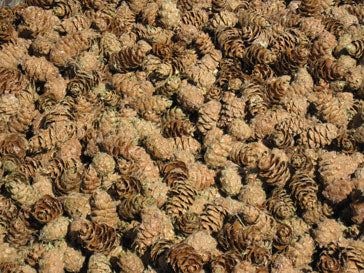
October 2023
Ever wondered about our tree planting process?
Well, here you go!
Step one:

After a wildfire in a National Forest, Forest Service experts inspect the area to determine if trees will grow back on their own or not.
Step Two:

To restore areas in desperate need of help, native species pinecones are gathered from areas with the same elevation and climate as the burned area.
Step Three:

Pinecones are shipped to a regional Forest Service nursery, where they dry and open.
Step Four:

Viable seeds are separated from the duds, and the good seeds are planted in high quality soil.
Step Five:

Baby trees grow in the nursery for over a year while Forest Service experts prepare the burned area and make sure it is safe for the workers and ready for planting.
Step Six:

The baby trees are shipped back to the forest for planting. They have a very high survival rate because they are genetically ready for the climate, altitude and soil conditions of the area.
Step Seven:

The baby trees are planted at the optimum time of year, usually late Spring or early Summer. They grow and thrive and THANKS TO FOLKS LIKE YOU, a forest is restored.
2021 & 2022 Angeles National Forest Update
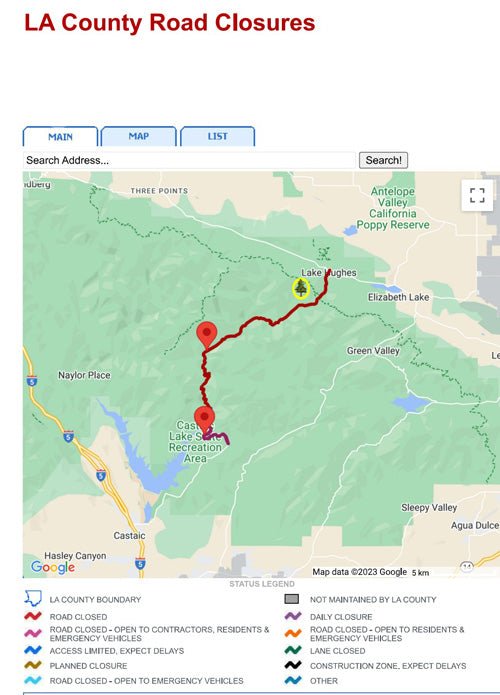
October 2023
The Angeles National Forest baby trees planted in 2021 and 2022 were seriously impacted by the drought of 2022, and many of the trees did not make it. This is highly unusual because the planting process is very carefully planned out by the Forest Service and our trees usually have a very high survival rate. (Learn more about that here.) This is actually the first time we have lost baby trees like this since we started in 2007.
We are committed to having a thriving baby tree in the ground for every single tree dedication, so we worked with the Forest Service to replant our 2021 and 2022 trees in a different location this summer.
Alas, we recently went to visit the trees soon after they were planted and the road was closed due to a mudslide. We were REALLY disappointed about this- we were very much looking forward to getting up there and getting you all new photos of the happy and healthy baby trees.
Please know the trees are doing well, we just can't access them right now. There is no projected date as to when the road will be repaired, but we're hoping we'll be able to finally take photos next Spring. Keep your fingers crossed, and know that we'll get there as soon as possible and we'll send another email when we make it.
Tree Updates 2022
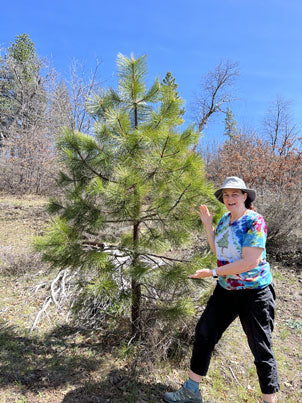
September 2022
To celebrate our 15 year anniversary, we're visiting our tree planting locations and taking updated photos. So far we've got new photos up for the following locations:
Gallatin National Forest, planted 2008
Plumas National Forest, planted 2009 & 2010
Shasta-Trinity National Forest, planted 2011 & 2012
Gallatin National Forest, planted 2013
Mendocino National Forest, planted 2014
Custom Groves
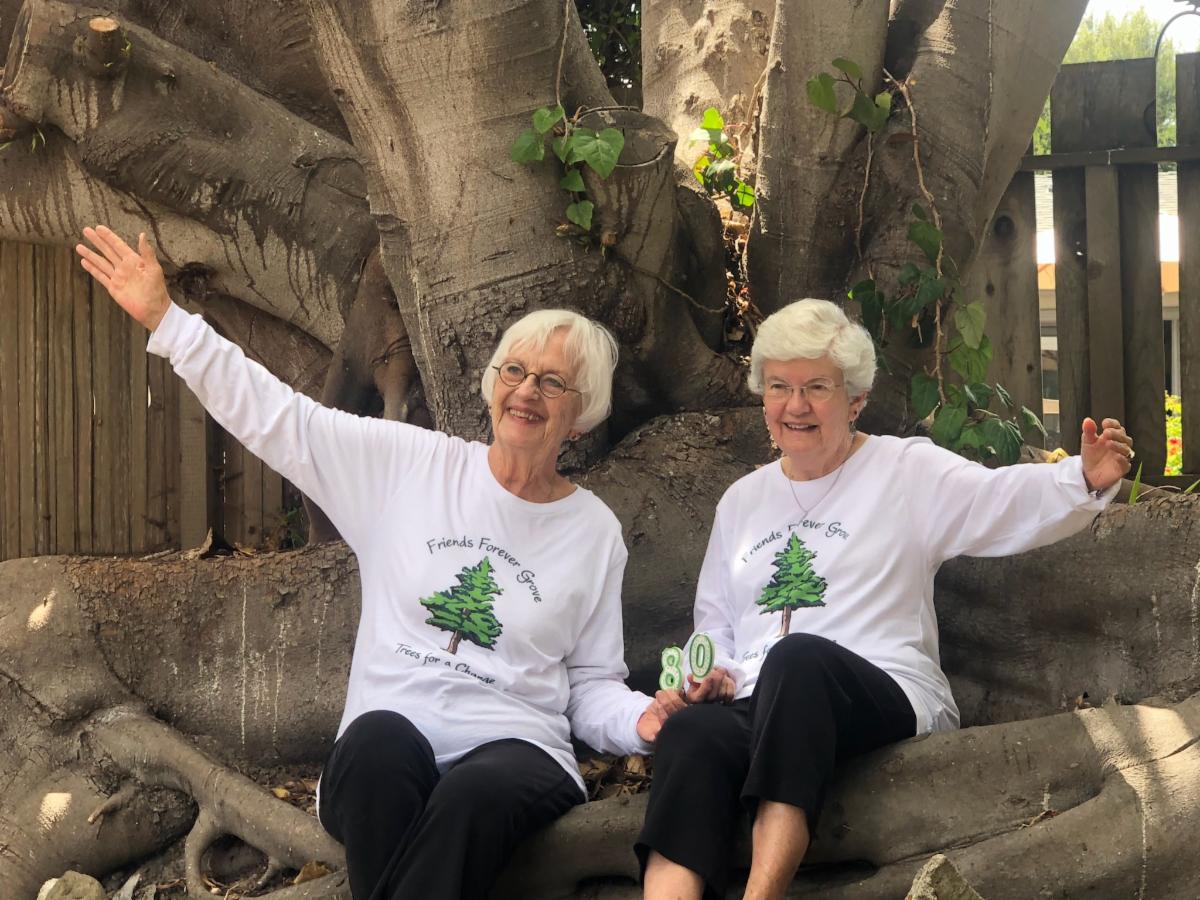
|
A Custom Grove allows family and friends to contribute trees to a larger grove for $10 each. The honoree or their family gets a beautiful framed certificate and a card after the contribution period is closed. Custom Groves are free to setup and only require a minimum commitment of 20 trees.
We can set Custom Groves up for any occasion, including birthdays, memorials, new babies, or anything else!
This Summer we had the honor of opening a Custom Grove for two very cool people, Darlene and Linda. These ladies have been friends for almost 50 years and were both turning 80 within a week of each other.
To celebrate their birthdays and their incredible friendship, they decided to open the Friends Forever Grove and ask friends and family to contribute trees instead of buying them birthday gifts. They were so proud of their (almost 300 tree!) grove, they asked for permission to make special shirts with our logo for a photo to send to contributors.
Happy Birthday, Darlene and Linda, and thank you for helping us restore the forest. May your trees grow and thrive in the spirit of friendship and love!
Tahoe Trees are Safe from Caldor Fire
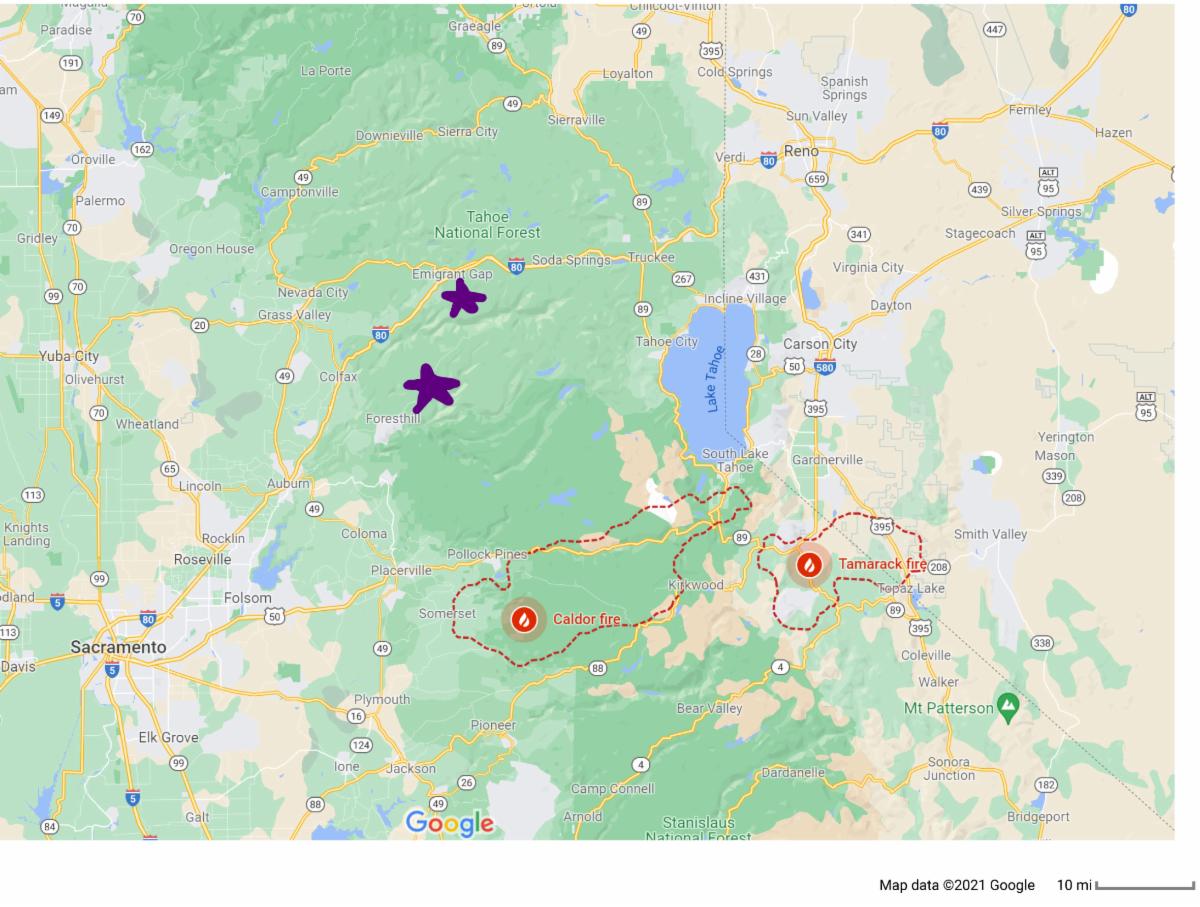
|
With news about the Caldor Fire burning into the Lake Tahoe area in CA, many folks are understandably concerned about the baby trees we've planted in Tahoe National Forest over the last few years.
And while reports of wildfire are always heartbreaking, the good news is that
this fire is not currently a threat to our Tahoe NF trees.
You can see on the map below the location of the fire compared to the
areas with the purple stars, where our trees are.
The fire is currently moving mostly Eastward, into the Lake Tahoe resort areas.
If you have questions about the risk to our trees when there are wildfires nearby, you might want to check out this post on the subject.
Are Our Trees Safe in the CA Wildfires Right Now?
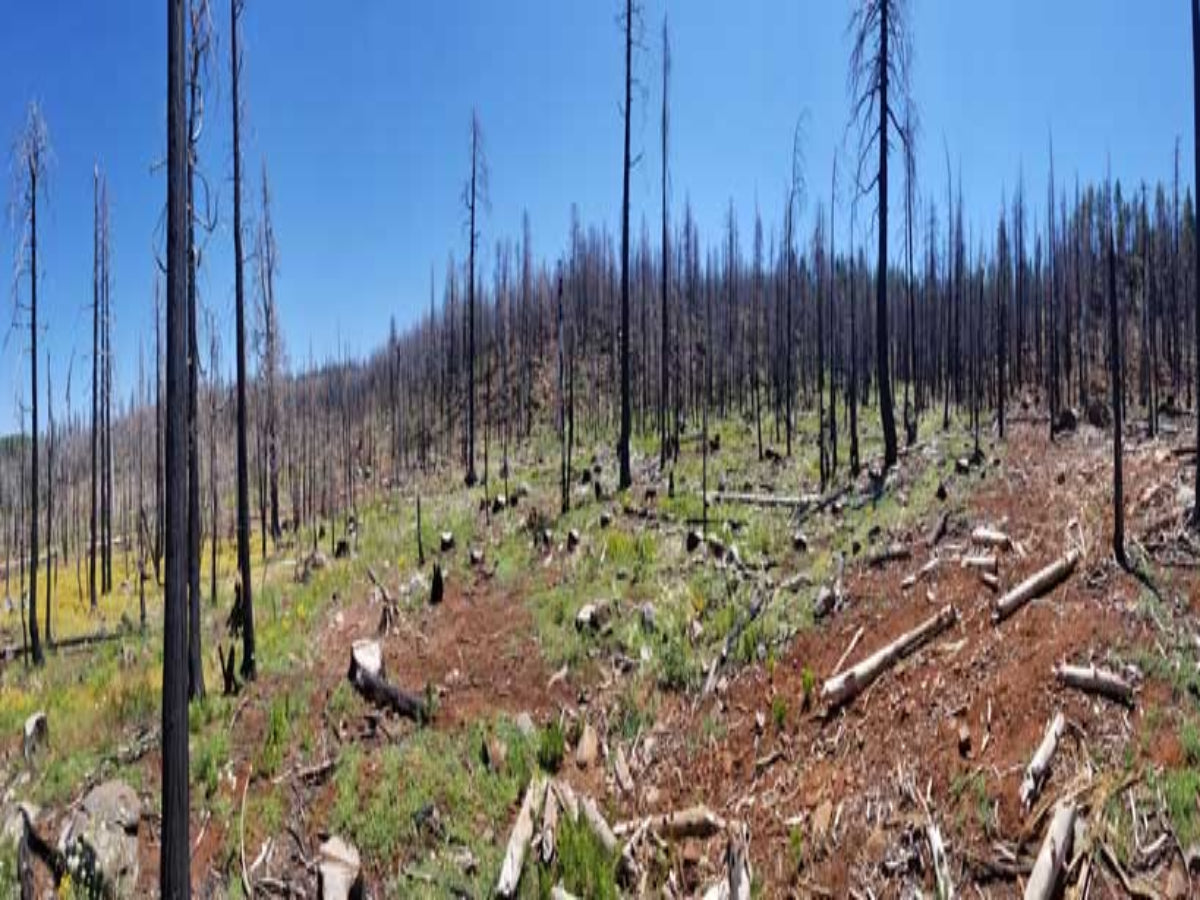

1) Fires need fuel. Our trees are planted to restore burned areas, so there is very little fuel for another fire to come through again soon after. It takes years to build up fuel (fuel= trees and ground cover like weeds, wildflowers, pine needles, pine cones, etc.) So, in general, the more recently our trees have been planted, the less likely a big fire will come through again any time soon.
2) The U.S. Forest Service experts plant our baby trees with science and years of experience behind them. The forests we help restore are often places that were overgrown and had an abundance of fuel for the fire that came through and destroyed everything. A current day forest management practice is to restore fire burned areas in way that will help avoid overgrowth in the future. So, our baby trees are planted 10' to 15' away from each other, which makes them grow into part of a healthier forest ecosystem that is much less likely to experience another catastrophic fire. So when you plant trees with us, you're not only contributing trees to the forest, but you're helping to make that forest less fire prone in the future too.
3) The Forest Service has for many years now been working on ways to plant more fire resistant trees. One of these ways is to use seeds from pine cones from trees that survived fire. They also have some experimental forests where they can study and cultivate trees that have thicker, more fire resistant bark and more heat tolerant pine cones. No matter where the tree baby seeds come from, they are always species native to the area they are being planted in.
So, while we can't make guarantees that the forest areas we restore will never be impacted by a future fire, the overall risk is fairly low and we feel confident that our trees will live and thrive for the benefit of all for generations to come.
|
As wildfires plague California yet again, folks wonder, "Are the trees I planted through Trees for a Change a year (or two, or five) ago going to burn up?"

The answer is our trees are most likely safe. And there are several reasons why:
1) Fires need fuel. Our trees are planted to restore burned areas, so there is very little fuel for another fire to come through again soon after. It takes years to build up fuel (fuel= trees and ground cover like weeds, wildflowers, pine needles, pine cones, etc.) So, in general, the more recently our trees have been planted, the less likely a big fire will come through again any time soon.
2) The U.S. Forest Service experts plant our baby trees with science and years of experience behind them. The forests we help restore are often places that were overgrown and had an abundance of fuel for the fire that came through and destroyed everything. A current day forest management practice is to restore fire burned areas in way that will help avoid overgrowth in the future. So, our baby trees are planted 10' to 15' away from each other, which makes them grow into part of a healthier forest ecosystem that is much less likely to experience another catastrophic fire. So when you plant trees with us, you're not only contributing trees to the forest, but you're helping to make that forest less fire prone in the future too.
3) The Forest Service has for many years now been working on ways to plant more fire resistant trees. One of these ways is to use seeds from pine cones from trees that survived fire. They also have some experimental forests where they can study and cultivate trees that have thicker, more fire resistant bark and more heat tolerant pine cones. No matter where the tree baby seeds come from, they are always species native to the area they are being planted in.
So, while we can't make guarantees that the forest areas we restore will never be impacted by a future fire, the overall risk is fairly low and we feel confident that our trees will live and thrive for the benefit of all for generations to come.

Wildfire Restoration FAQ
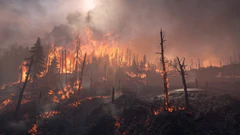
|
August 2021 It's wildfire season, and there are fires burning all over the U.S. right now, so we thought we'd answer some frequently asked questions about forest fire restoration.
 Isn't fire good for a forest sometimes?
Yes, in a healthy forest, a fire will clear out a lot of brush and smaller trees and leave the older, more established trees standing and thriving with less competition for resources. But in an overgrown forest that is dry and dense, fires can completely obliterate trees and pine cones.
What is a "healthy forest?"
In a healthy forest, the trees have proper spacing so they get plenty of water and sunshine to thrive. Fire suppression practices of the past (we used to think all fire was bad and we tried to put them all out) have led to more dense forests. And, climate change and drought have dried out our trees so some of our forests are now more susceptible to disease and fire devastation.
Why do some forests regrow themselves after a fire and some don't?
If pinecones managed to survive the fire, then trees will likely be able to grow on their own in that area eventually. However, if the fire got hot enough to destroy most of the pinecones, then the area will need help with restoration as the trees won't be able to regrow on their own.
Don't some pinecones need fire to open up and distribute seeds?
Yes, these are called serotinous cones and they require high temperatures to melt the waxy coating on the cones and open them. However, even serotinous cones can be destroyed in very high temperature fires.
Why is it important to restore fire burned areas through Trees for a Change?
Our trees are always planted in areas the U.S. Forest Service has specifically designated for restoration, areas where the burned trees will not regenerate on their own. Our trees are planted and managed to become a healthy forest that will be less susceptible to fire devastation in the future. Healthy forests contribute greatly to our eco system and help fight climate change.
|
|
Every tree makes a difference!
|
Isn't fire good for a forest sometimes?
Yes, in a healthy forest, a fire will clear out a lot of brush and smaller trees and leave the older, more established trees standing and thriving with less competition for resources. But in an overgrown forest that is dry and dense, fires can completely obliterate trees and pine cones.
What is a "healthy forest?"
In a healthy forest, the trees have proper spacing so they get plenty of water and sunshine to thrive. Fire suppression practices of the past (we used to think all fire was bad and we tried to put them all out) have led to more dense forests. And, climate change and drought have dried out our trees so some of our forests are now more susceptible to disease and fire devastation.
Why do some forests regrow themselves after a fire and some don't?
If pinecones managed to survive the fire, then trees will likely be able to grow on their own in that area eventually. However, if the fire got hot enough to destroy most of the pinecones, then the area will need help with restoration as the trees won't be able to regrow on their own.
on't some pinecones need fire to open up and distribute seeds?
Yes, these are called serotinous cones and they require high temperatures to melt the waxy coating on the cones and open them. However, even serotinous cones can be destroyed in very high temperature fires.
Why is it important to restore fire burned areas through Trees for a Change?
Our trees are always planted in areas the U.S. Forest Service has specifically designated for restoration, areas where the burned trees will not regenerate on their own. Our trees are planted and managed to become a healthy forest that will be less susceptible to fire devastation in the future. Healthy forests contribute greatly to our eco system and help fight climate change.
